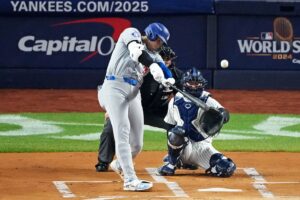2020 Arizona Diamondbacks Draft Recap
The Arizona Diamondbacks Draft in 2020 saw them select five players across five rounds. Four were pitchers and one was a third baseman. Three were college players, while two were high school seniors. Here is a look at the five.
Round One, Pick 18: Bryce Jarvis, RHP, Duke University
Bryce Jarvis – son of retired pitcher Kevin Jarvis – is a 6’2”, 195-pound pitcher from Duke University. Diamondbacks Scouting Director Deric Ladnier said that what caught the team’s attention was his “advanced ability to use four pitches and ability to pound the strike zone.” Another factor that Ladnier called “quite intriguing” is that Jarvis has “already mastered” skills that the Diamondbacks try to get players to develop when they enter the system. These skills include pitch shape and design as well as “tunneling” – something that it takes time to learn. The Diamondbacks draft based on ability, of course, but a bonus for Jarvis was that he has the “advanced approach to pitching, which is going to allow him to advance quickly through our system and, hopefully, impact our major league club.”
Ladnier has known Kevin Jarvis for years, so he got to see Bryce in his high school days. He told Kevin, “I like him, but he’s not where he needs to be. This is the perfect guy that needs to go to college and prove that he’s gonna be something.” Kevin said, “He’s gonna be something. I promise you, he’s gonna be something.” While Bryce was at Duke, he certainly showed he was “gonna be something,” with his pinnacle achievement being the perfect game he pitched against Cornell on February 21.
Bryce is not just talented on the field, but he is also talented scholastically. The mechanical engineering major is someone who is “wired for success,” according to Ladnier. Bryce told reporters on draft night that he will finish his degree. The Diamondbacks are thrilled to have him – so much so that as their turn in the draft drew close, they were hoping and praying no one else would take him.
Competitive Balance Round A, 33rd Overall Pick: Slade Cecconi, RHP, University of Miami (Florida)
Slade Cecconi – 6’4”, 219 lbs – is a right-handed pitcher from the University of Miami in Florida. When initially asked, Ladnier said, “Yeah, I was sweating that one out, too,” regarding whether Cecconi would still be available. He continued, “He’s got the size and stuff – a four-pitch mix. (Cecconi) is really intelligent.” Although he’s “not as advanced” in his “ability to control the zone” as Jarvis is, “he’s an elite strike-thrower.” He’ll need more development in the ability to “utilize his pitches,” something Ladnier hinted could be fixed through gaining more confidence with his third and fourth pitches.
One area where Cecconi is strong, indicating that he might be able to address pitch confidence quickly, is familiarity he has with the data that the Diamondbacks use with their major- and minor-league players. “He’s up to par on everything,” Ladnier said. He continued that, like Jarvis, Cecconi is an “advanced thought-process guy with really good stuff.”
Round Three, 90th Overall Pick: Liam Norris, LHP, Green Hope High School, Cary, North Carolina
Liam Norris, who stands 6’4” and weighs 215 pounds, is a left-handed pitcher from Green Hope High School in Cary, North Carolina. According to Ladnier, what the team liked about him last summer was the “body, the arm action, the velocity, and the rotation on the breaking ball.” He said that last summer, Norris’ command and control were “just ok, but the stuff was there.” Last year, the team pinned him as a guy they “wanted to make sure we saw early,” and, “thankfully, we did.” This year, before the season came to an abrupt halt, his command was “two grades better,” his fastball was up to 96, and his breaking ball and changeup were developing.
What amazed Ladnier in the Zoom call they had with Norris was how advanced his “pitching IQ” was. He understood the aspects that Ladnier mentioned when discussing Jarvis – pitch shape, pitch design, and tunneling. Because of this, the Diamondbacks selected him and made it a goal to sign him, even though he has already committed to play baseball at the University of North Carolina.
Round Four, 119th Overall Pick: A.J. Vukovich, 3B, East Troy (Wisconsin) High School
High school senior A.J. Vukovich is a 6’5”, 210-pound third baseman from East Troy High School in East Troy, Wisconsin. He has committed to go to the University of Louisville, but his “body, . . . strength, and athletic ability” were such that the Diamondbacks decided they’d try to lure him away. Ladnier said, “We see him as a third baseman but the thing about it is he’s so athletic he could probably play anywhere – probably not to the level of playing up the middle like shortstop or second base.” He continued, “We like the power, the bat, the speed, the strength, the projection, (and) the body.”
Because Vukovich lives in Wisconsin, the Diamondbacks had to rely on their scouting from last summer. “We had one report from an area scout at a scrimmage. That was about it.” However, they had “20 different reports from 20 different guys” from his time in the summer. His prowess in another sport also contributed to their opinion of his athletic ability – he scored over 2,000 points in his high school basketball career. Ladnier concluded, “We like him at third base. We’ll leave him there,” but added that he’s going to “develop and grow” and might “grow out of that position.”
Round Five, 149th Overall Pick: Brandon Pfaadt, RHP, Bellarmine University
Brandon Pfaadt, a pitcher from Bellarmine University in Louisville, is 6’3”, 220 pounds. Ladnier said their reports on Pfaadt came both from the Cape Cod Summer League and from the shortened Spring of 2020. His fastball is “up to 96,” going with a “plus curveball, feel for a changeup, (and a) really good delivery.” Pfaadt is a “big, strong, durable guy that we felt had upside as a starter like Liam Norris. To get him where we got him, we were pleased. We had really good reports on him.”
Outlook
At first glance, many would assume that the Diamondbacks went into the draft with a heavy focus on pitching, but that is not true. Both Hazen and Ladnier relayed to reporters in post-draft interviews that the organization had a “best guy available” strategy. The Diamondbacks draft team crossed a player off their board – one that was filled with both pitchers and position players – whenever a team picked him. When the Diamondbacks got their turn, the top guy on their board who hadn’t been picked yet just so happened to be a pitcher four of the five times.
The next step in building the organization is signing the undrafted free agents. This is a tremendous unknown, but Ladnier thinks “it’s going to be crazy. Every team is going to be calling similar people. Ultimately, they’ll make a decision to sign, and if they have 10 clubs that are interested,” the player will have to make a decision. Ladnier likened the process to recruiting. He added that they’ll only go after guys whom they feel are definite prospects and not borderline guys.
The big question now – one that will remain after the undrafted free agent signing process – is what to do with these prospects from a developmental standpoint. If they don’t play, they regress. The minor leagues have been in a holding pattern since March. Serious doubt persists as to their ability to play at all in 2020. Ladnier said he’d like to see some type of instructional league or leagues show up as soon as possible, but he doesn’t know when that will be. This must be resolved soon since the players are all eager to get to work on the next phase of their baseball careers.
Main Photo
Embed from Getty Images






